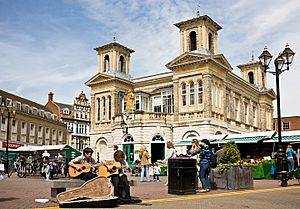List of market towns in London facts for kids
Imagine a time before big supermarkets and shopping malls! People used to get their food and goods from special places called 'market towns'. These were towns that had a special permission, called a 'market right', from the King or Queen to hold regular markets. This article explores some of these historic market towns that are now part of the huge city we call Greater London.
Contents
What is a Market Town?
A market town wasn't just any town with a market. It was a place given a special 'charter' or permission by the monarch (the King or Queen). This charter allowed the town to hold a market on specific days. Having a market was a big deal! It brought people from all around to buy and sell things like food, clothes, and tools. This helped the town grow and become important.
The 'market right' meant that only certain towns could hold these official markets. This made them important trading hubs for the areas around them. Over time, some towns stopped using their market rights, while others revived them later.
London's Historic Markets
Many centuries ago, before London grew so big, these market towns were separate places in the countryside around it. As London expanded over hundreds of years, it eventually surrounded and included these towns. Even though they are now part of a huge city, many still remember their market town roots. Some even have busy markets running today!
The earliest known charters for these markets date back hundreds of years. For example, Barking received its market right in 1175, and Uxbridge in 1180. These dates show how long these towns have been important places for trade.
Some Famous London Market Towns
Let's look at a few examples of these historic market towns that are now part of Greater London:
Kingston upon Thames
Kingston upon Thames is a very old market town. It got its market charter in 1208. Today, Kingston Market is still a lively place where you can find fresh produce, street food, and other goods. It's a great example of a historic market that continues to thrive.
Romford
Romford received its market charter in 1247. The Romford Market is still very active and is one of the largest and oldest street markets in the south east of England. It's a central part of Romford's identity, celebrating its long history of trade.
Croydon
Croydon was granted its market right in 1276. Its famous Surrey Street Market is one of the oldest street markets in the UK. It has been a place for buying and selling goods for centuries, showing Croydon's long history as a trading centre.
Enfield
Enfield received its market charter in 1303. The Enfield Market continues to operate today, offering a variety of goods to local residents. It's another example of a market that has adapted over time but kept its historic purpose.
Markets Today
While some of these historic markets, like those in Edgware, St Mary Cray, and Westminster, no longer exist, many others are still busy and important parts of their communities. They remind us of how people used to shop and how towns grew around these important trading places. These markets often sell everything from fresh food to clothes and unique crafts. They are a link to the past and a vibrant part of London's present.
See also
- List of markets in London
- Market (place)



